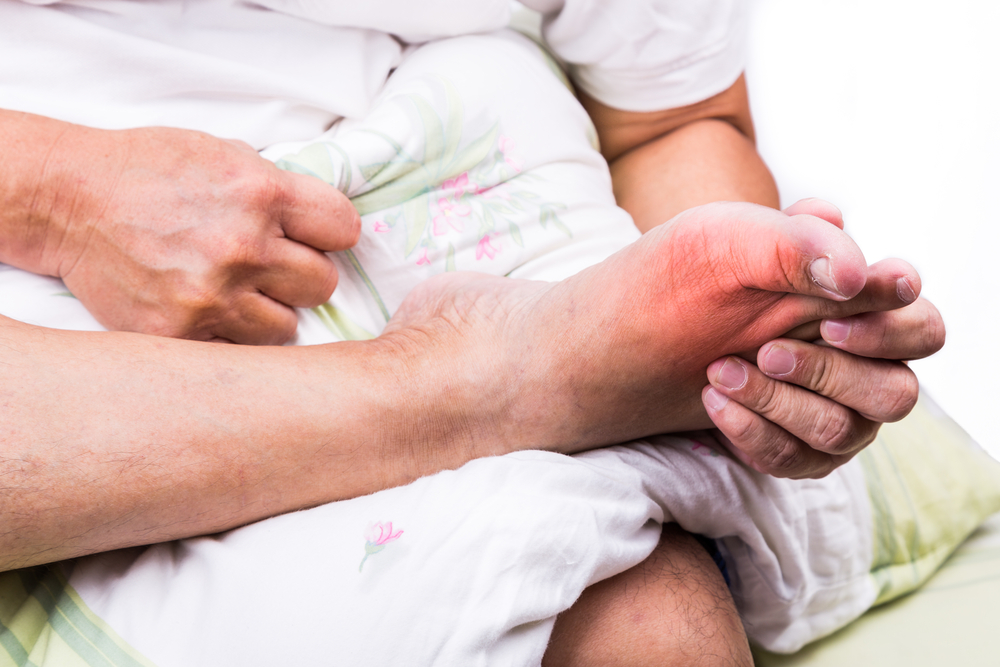Gout (also called “hyperuricemia”) is a form of arthritis (an inflammatory disease), often very painful, that primarily affects men aged 50 and over. According to the Arthritis Society, gout affects approximately 5.2% of men and 2.4% of women in Canada. Western countries are the most affected.
The most common form of gout occurs in the big toe, although it can also affect other joints.
This type of arthritis is caused by an excess of uric acid in the blood. Uric acid is an organic waste product that your cells secrete when they die or when you digest food. Normally excreted in the urine, uric acid can still build up in the body if it is not eliminated properly. It then accumulates as crystals in your joints, causing gout problems.
There are several possible causes for excess uric acid, including:
- Diabetes
- Poor kidney functioning
- Overweight
- Genetics
- Poor nutrition
- Hypertension
- Alcohol abuse
But how can we recognize gout? And more importantly, when should we be worried?
Here are 5 signs to watch for that should encourage you to consult a podiatrist.
1. Significant pain in the big toe
In the vast majority of cases, gout first appears in the big toe. And it is often a very painful condition. Walking becomes difficult and you feel a burning sensation in your foot. You may also feel like your foot is stuck in a vice.
These pains often occur at night. So it is often during your sleep that you will realise that something is wrong. You may also experience other symptoms:
● Hypersensitivity when you touch your foot;
● Pain that spreads to other joints, such as the ankle and knee;
● Paralysis of the toe (in extreme cases).
If you are experiencing the above symptoms, it is very important to rest your foot and consult a qualified medical professional, like a podiatrist. The pain tends to go away after a few days, but this does not solve the problem.
2. Inflamed, swollen joint
One of the first symptoms of gout is a swollen, red or purplish foot. The foot usually becomes painful to the touch.
This swelling may spread along the leg or to other joints affected by gout. It occurs due to the accumulation of uric acid crystals, causing local inflammation in the affected joint.
In some cases, this can make it more difficult to wear shoes, as well as for everyday activities. To help relieve this condition, apply cold compresses, drink plenty of water and consult a podiatrist without delay!
3. Frequent fever
Inflammation of one or more joints in your body often causes recurring fever. Even if the fever is not very intense, it can become quite debilitating.
Other health problems may also develop:
● Nausea
● Headaches (migraines)
● Intense fatigue
● Sweats
● Shivering sensations
4. Itching and flaking
Gout can cause itching of the skin, also known as “pruritus.” The foot’s skin tends to stretch due to the inflammation caused by this condition.
As a result, the foot becomes itchy and tingling. Flaking of the skin (exfoliation) may also occur.
In more severe cases, the skin cracks, which can cause bleeding. When this happens, apply an antibiotic cream (available at most pharmacies) and cover it with a bandage. If you wait too long, your foot can become infected.
5. Deformity and lack of joint mobility
An excessive amount of uric acid crystals in your joints can cause considerable swelling, which interferes with your mobility and the fluidity of your movements. Your joints can become deformed over the long term and lose their natural mobility.
Another case where the podiatrist becomes essential!
PiedRéseau: your clinics to prevent and treat gout in the big toe
PiedRéseau regroups some forty podiatric clinics across the province of Quebec. At each clinic, you will find concrete solutions to treat your gout issues in your big toe.
In spite of all your precautions, sometimes this complex form of arthritis needs to be treated with your doctor for a more effective management of this pathology. PiedRéseau has all the expertise and equipment required to provide relief for your feet.
Find the PiedRéseau clinic nearest you to take advantage of exceptional podiatric treatments.

